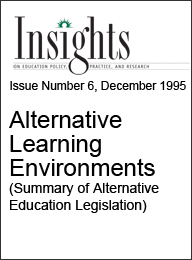Alternative Learning Environments (Summary of Alternative Education Legislation)
Introduction
In light of recent legislative action mandating alternative education in several states in SEDL's Southwestern Region, this issue of INSIGHTS focuses on alternative programs for students at-risk of educational failure. It attempts to illuminate the underlying goals of creating alternative learning environments, and explores the implications of current research for designing effective programs and schools. As alternative environments are implemented, policymakers are encouraged to assess the impact of alternative programs on the rest of the educational system and to consider their potential role in broader school reform.
"Alternative education is a perspective, not a procedure or program. It is based upon the belief that there are many ways to become educated, as well as many types of environments and structures within which this may occur. Further, it recognizes that all people can be educated and that it is in society's interest to ensure that all are educated to at least...[a] general high school... level. To accomplish this requires that we provide a variety of structures and environments such that each person can find one that is sufficiently comfortable to facilitate progress." (Morley, 1991, p. 8)
Morley's definition implies that the primary goal of alternative education is to help young people become productive members of society. Furthermore, it assigns a large part of the responsibility for achieving that goal to the school system, suggesting that schools meet students' differing needs rather than expect them to conform to one particular educational environment. Alternative education proponents and other education reformers certainly view this goal as an important one (Morley, 1991; Raywid, 1994b). A long history of educational initiatives for students facing challenging situations is evidence of the belief in helping all students succeed.
A second goal also drives the establishment of alternative education programs: the need to remove disruptive influences to create classrooms that are productive and safe. Many educators and policymakers recognize this need, but disapprove of discipline policies that merely facilitate the removal of suspended and expelled students from schools. Such removal often leaves these students without adult guidance or supervision (Jacobs, 1994).
These dual goals -the desire to increase graduation rates and the need to eliminate disruptive or violent students from classrooms without sending them into the streets-has led many policymakers to embrace alternative education. Three out of the five states in the Southwestern Region served by SEDL have enacted legislation mandating alternative education. Arkansas, Louisiana, and Texas require every school district to provide an alternative learning environment for expelled and suspended students. A fourth state, Oklahoma, actively encourages and supports the creation of alternative programs by awarding grants, evaluating programs for effectiveness and replicability, and providing state validation for those that receive high ratings.
In recognition of these legislative actions and their intent, this issue of INSIGHTS focuses on alternative programs designed for students at-risk of educational failure in traditional schools and classrooms. It attempts to illuminate the underlying educational goals of alternative learning environments and to explore their policy implications. Current legislation in the Southwestern Region makes it imperative not only to understand if and how alternative schools help students in at-risk situations, but also to consider alternative schools' role in overall educational reform and restructuring. Therefore, if policymakers and educators strive to ensure an effective education system for all students, whether at-risk or not, they should consider several issues:
- Do alternative schools work?
- Which programs work best?
- Do mandates for alternative education affect its success?
- Are there consequences for the rest of the educational system?
This issue of INSIGHTS begins to address these questions.
Next Page: Summary of Alternative Education Legislation in SEDL's Southwestern Region

